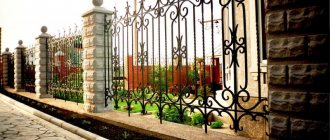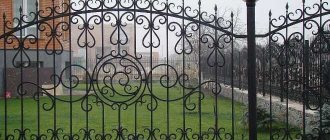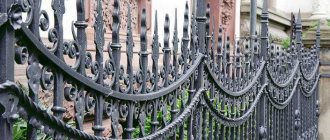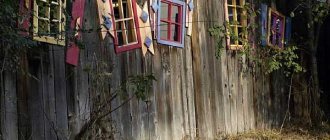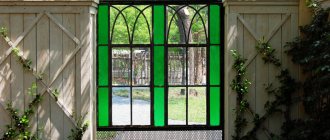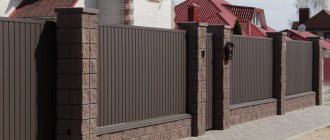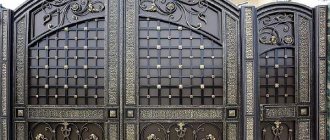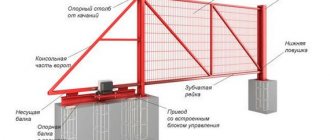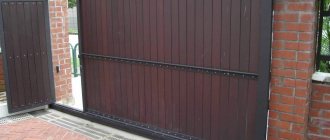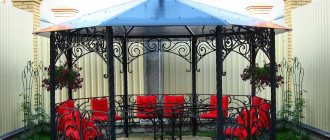Forged elements represent a large category of small decorative parts that can also perform a protective function. The most popular among customers for decorating fences are finials, finials and peaks. These products are used as a supplement many designs: fences, gates, wickets, fences, cornices, stair pillars, gazebos, window grilles and others. This article will focus on the use of finials, peaks and finials as an additional element for various types of fences.
A photo gallery of all types and forms of wrought iron fences is presented in the corresponding section. The catalog of photographs is constantly updated. Blacksmiths and companies have the opportunity to submit their work. Information will be posted, basic information about the products and their author will be indicated. This type of cooperation will be an excellent advertisement for both individual craftsmen and commercial enterprises.
Those wishing to purchase or order a wrought iron fence can familiarize themselves with the catalog of companies offering structures of various designs and sizes.
What is what, what's the difference
Some customers often confuse peaks, pommels and tips, mistakenly believing that these are the same elements. Therefore, it is important to know what the differences are between these parts.
Product form. A pike is an element with a pointed end.
The tips can have a variety of shapes with a round, pointed, multifaceted, dome-shaped end; exclusive types are quite common.
Pommels can also have a variety of configurations.
Dimensions. Tips and peaks are small forged parts. Tops can be of two types depending on their purpose: compact ones are designed for placement on poles, elements of larger sizes are used for spans.
Functions performed. All of the above elements perform protective and decorative functions at the same time.
However , the peaks make the fence more of a barrier to illegal intrusion.
Combination with various materials. Peaks and tips look most harmonious with forged and welded structures. The finials look organic with different textures: metal, brick, stone.
Difficult to install. Peaks and tips are easily attached to the fence by welding. The completion of the top to the fence and especially to the posts is often carried out using fasteners.
Types of forged fences
Metal lace will not become a barrier to the penetration of the same animals, since it itself is transparent and has numerous holes. Therefore, almost all forged gates and fences are made in combination with other materials. An opaque material is placed behind the forged weave.
Posts for welded and forged fences
Forged or welded sections are installed during the manufacture of a metal fence on posts made of metal or brick (stone). These are the main, most commonly used supports.
When installing a combined type of fence, when an opaque material is mounted behind a forged section, brick columns will be the best option.
Such a base is reliable and can withstand any wind, since the combined fence has a high windage.
Sections with metal or profiled sheets
Often there are combinations of a forged part of the fence, behind which a painted sheet of metal is mounted. Typically profiled roofing sheets are used. It has a factory paint job designed to withstand extreme weather conditions.
In this option, the forged elements are painted black, and the color of the metal behind it is matched to the tone of the roof of the house.
But the profiled sheet has a formed relief, which, in combination with forging, not everyone likes. Therefore, a metal sheet treated with an anti-corrosion agent, primed and painted is used. This option is ideal for selecting any desired color: silver, gold, bronze and other, even unusual shades.
The combination of forged sections with metal sheets is a reliable fence. The strength of the metal sheet is reinforced by a lattice of forged elements. The composition turns out beautiful and organic. And the openwork forged bindings look impressive against a colored background.
Forged sections with polycarbonate
In the last five years, wrought iron gates and fences have often been supplemented with materials such as polycarbonate. It is produced not only in cellular form, but also in sheet form. Sheet polycarbonate is more durable and can even withstand stone impacts.
Polycarbonate is available in different colors. Brown, bronze, matte white with shades are popular for fencing. Any type of material cuts well. This allows it to be used to decorate individual parts of the fence, for example, to make colored inserts.
Forged sections with wood
The tree itself is both decorative and durable for creating fences. But when combined with forged elements, fences and gates turn out much more beautiful
There are two options for welded or forged fences with wood.
The first option is a forged metal frame with forged elements located. This frame is filled with boards tightly adjacent to each other. Sometimes they build only a frame around the perimeter, and patterned elements on top/bottom.
The combination of metal and wood - how beautiful and exclusive it turns out:
The second option is sections of a forged fence, which are covered with boards on the yard side. Only occasionally are boards inserted into metal frames. The difference from the first option is that the metal frame can be a fence without boards, they are only an addition.
What both customers and performers need to know
Forged elements are distinguished by a variety of shapes and affordable prices. These factors make such parts in demand both among customers and craftsmen who prefer to create forged products themselves. No matter what type of customer you are, there is information that will be useful to everyone.
Trading enterprises sell forged elements individually and in batches (packaging form is a box). Most companies sell not only retail, but also wholesale. Large orders provide the client with a discount.
Each company offers a wide selection of items . If necessary, specialists will design and create exclusive items. Some artists prefer to produce original parts themselves. This allows you to experiment with product shapes and sizes.
There are several methods of delivery (pickup, mail, transport company) and payment (cash and non-cash). All this guarantees convenience and comfort of cooperation.
If the client needs a large number of identical elements, then it will be easier and faster to buy finished products rather than making the parts yourself.
If you have certain skills in the field of welding, it will not be difficult for the contractor to assemble the structure . However, in order to avoid difficulties during configuration and difficulties during operation, it is recommended to entrust the installation procedure to a specialist.
It will not be difficult to process the product yourself.
It is important to give preference to trusted companies with a good reputation.
Metal fence
There is a wide variety of both standard and unique metal products.
Leaving aside the metal structures used in construction, the main area of use of forged products is all kinds of fencing: fences (and, accordingly, wickets and gates), railings, gratings. And if, in the process of difficult choice of material and shape of the future fence, you give preference to metal, you will never regret it.
Subject to high-quality manufacturing and installation of the product using the required technology.
Usually, when deciding on the choice of a fence for his site, the customer focuses on:
- wear resistance;
- external attractiveness;
- efficiency.
Will metal benefit in comparison with other materials used in fencing assembly?
Advantages of a metal fence
- Structural strength. Its ability to withstand heavy loads, from which, for example, a brick analogue will simply crumble, and a concrete one will crack.
- Good degree of protection of the fenced area. Because jumping over a high wrought-iron fence decorated with peaks (the most popular element when choosing a sketch) is not only difficult, but also dangerous.
- Durability. The service life of such a fence, provided it is properly processed during manufacture and installation, is practically unlimited.
- Unpretentiousness. A fence that has been properly painted with the right paint will not require restoration for many years.
- A huge selection of styles to suit every taste.
- Undeniable beauty and the ability to create an exclusive fence that no one else will have but you.
Disadvantages of forged construction
When choosing a material for making a fence, you need to decide what is your priority - aesthetics or a protective function. However, on both counts, forging is ahead of its concrete, brick or wooden counterpart.
Beautiful wrought iron fences in private homes always attract attention to themselves and their owner, but, in all respects, they are suitable not only for a private home, but also for fencing all kinds of park areas and government institutions.
At the same time, the variety of models allows you to choose the best option that will meet all customer requirements.
But metal structures also have their drawbacks.
- Increased cost.
- Often huge weight.
- Professional installation required.
- Mandatory treatment of the product with an anti-corrosion solution every 3-4 years.
With an objective analysis of all the pros and cons, it becomes clear that in the conditional struggle of metal, brick and concrete, the first will prevail. In addition, the cost of products made from this material varies greatly. You can always choose a sketch to suit every taste and budget. And the quality does not suffer from this (!)
Finials
Forged finials are elegant parts of fences; they give structures a complete look, attract attention, and amaze the imagination with their intricate and whimsical shapes.
Functions
There are two types of pommels , differing in their dimensions:
- elements for pillars are small in size;
Work by Sergei Frolov
- structures of considerable size are designed for fence spans; they are also called overfences.
Photo “Forge factory of Valery Litvinov”
Both categories of products perform decorative and protective functions.
Kinds
Finials organically complement fences made of various materials, as well as combined models.
On brick, stone, concrete
Brick is an excellent material for constructing a reliable and durable fence. Finials will be a great finishing touch for this type of structure. This combination is a classic option.
The stone has a wide range of advantages: strength, durability, originality, and the absence of the need for constant maintenance. Finials in Gothic, classical or avant-garde styles are perfect for a stone fence.
Concrete can be present in the structure in the form of a strip foundation or as pillars. The least common are concrete spans. The advantages of structures with concrete components: affordable cost, capital construction, durability, the material does not rot or rust. Finials can add an original detail and zest to the fence.
On transparent forged
The classic version of a wrought iron fence is best decorated with tops for posts. The design of the spans may already include peaks that perform the necessary functions. But supports without decoration will look poor and unfinished. An example of a round finial on a pillar is shown in the photo.
Photo “Flieger”
In a semicircular opening
A fence with a semicircular opening has a spectacular and exclusive appearance . A common option is a combination of brick spans and pillars with forged tops. An example of such a design is shown in the photo.
Posts for wrought iron fences
The preparatory work stage is very important when making a fence. It necessarily includes the preparation of strong and reliable supports. These elements should not only be durable and functional, but also aesthetically attractive.
The most popular are the following elements and materials for fencing:
- Metal. Such supports can withstand severe mechanical stress. The existing advantages of metal supports include: favorable pricing policy, the absence of complex installation work, ease of installation and transportation. Square or round pillars can be used as reliable supports, which will give the fence an additional frame.
- Made of brick. This type of fence is not only durable, but also aesthetically beautiful. Facing bricks are often used for supports, from which columns are then erected. However, before starting construction work, it is worth taking care of the foundation. Otherwise, cracks and subsidence may subsequently occur in the brick structure, which is extremely undesirable.
- Concrete pillars and asbestos pipes. These materials also look good with metal structural elements. They are as reliable and durable as the options listed above. However, there is one criterion - asbestos pipes are used only for those fences whose height does not exceed 1.5 m.
Stone pillars
Peaks
Companies offer a wide range of peaks:
Forged lances can be produced in accordance with hot and cold technology. The first category of elements is created with preheating of the workpiece, the second - without it. Shapes and lines are given to the parts by hand.
Stamped peaks have a more affordable price, since they are produced using automated equipment.
Cast peaks can be made of cast iron and steel. Trading companies often classify cast elements as cold forging. And buyers, in turn, do not see the difference.
Therefore, be careful and clearly indicate to the specialists what parts you need.
Functions
Initially, the peaks performed a purely protective function. However, now buyers can find a large selection of beautiful and magnificent elements, characterized by a variety of lines and outlines. In this case, the original function of the part is perfectly fulfilled.
Kinds
Peaks improve the appearance of a wrought iron fence with a “transparent” structure , and also provide more reliable protection. Peaks can be placed both on metal pillars of the structure and on spans.
The standard design of a welded fence can be supplemented with unique and unusual elements.
Photo “Timergrad”
Combined fences decorated with peaks are popular
Photo “Kovka-Opt”
It is more expedient to decorate pillars and spans of brick, stone and concrete structures with finials.
Forged metal fences
Since 1997, ROVAND FORGING has been manufacturing and installing metal fences and fences - from simple welded ones to the most sophisticated, hand-forged ones. Any of our fences will serve, first of all, to protect your territory, and secondly, to decorate your home. As a rule, it consists of metal sections (forged or welded), support pillars, entrance gates and wickets.
There are several types of installation of metal fences and barriers.
- Installation of fence sections between metal posts that are concreted in the ground or in the base. The sections are welded to metal posts.
- Installing fence sections between concrete or brick pillars. In this case, before pouring or laying the pillars, it is advisable to provide embedded parts to which the sections are welded.
- Installation of forged decorative fencing on brick or concrete fences. Fencing elements are installed above a finished stone fence or in an opening between posts.
We will manufacture and install wrought iron fences. The design can be of any complexity.
You can make a pre-order and buy a fence with various design options directly on the website or in our office. Choose a sample that suits you from the catalog and order using its number. In a short period of time you get a reliable, beautiful and solid fence for your home and summer cottage. We offer products in various price categories.
If you are hesitant to order a forged fence, we can offer you a simpler analogue - a welded fence made of rolled metal with forged elements. And to decorate the gate, canopy and wicket of such a fence, you can use more complex elements made of forged metal.
All fences and railings we manufacture are treated with protective paints.
The special composition included in them allows you to preserve the surface of the product from corrosion for a long time. The use of additional coating in the form of artistic patina treatment (gold, bronze, copper, silver) will give a special original look to the finished product. The cost of fence samples
is indicated taking into account the metal section without concrete plinths, posts and installation. The cost of installing poles, pouring a concrete base, and installing a fence is calculated individually, based on the complexity and location of installation. To calculate the installation, contact our specialists.
Watch the video we filmed of painting forged products.
Tips
The tips give the structures a finished look and add aesthetics and attractiveness to the fence. There are different types of these elements: parts created in accordance with hot and cold forging technologies; stamped; cast.
Photo “Podkova.ru”
Functions
Wrought iron tops can decorate the metal fence posts as well as the bars that form the base of the section of the structure.
Kinds
The tips are actively used for decorating forged and welded fence sections, as well as metal posts.
Forged fence with tips on posts from the Tekhinkov company
Combined designs are often decorated with finials.
Photo “Tekhinkov”
Which to prefer: welded or forged gates (fence)
Forged and welded gates and fences are made from metal, but different technologies are used. Both welding and forging use the elasticity of the metal. But this quality is applied differently in different processes and conditions.
During forging, a rod (metal blank) is heated, brought to a certain temperature, and the required shape is given to the rod by pressing.
There is a huge variety of shapes, because heated metal is very plastic, all kinds of twisted and openwork elements can be forged from it.
Having forged the required number of forged blanks, the master combines them into sections.
The sections are then mounted on pre-erected support pillars. Since the work is carried out with softened metal, it is possible to combine the fencing elements into a single structure with virtually no seams. Due to this process, a forged gate or fence looks very neat.
Of course, forging is an expensive and time-consuming process, but the fencing turns out to be exclusive!
In the manufacture of welded gates and fences, the elasticity of the metal is also used, but only in a cold state.
During the welding process, bent and twisted elements are obtained from the rod, and the manufacturing itself is called “cold forging”.
To obtain elements for welded gates of various shapes, there are special devices with which you can change the shape of the workpieces without heating. And since the metal has less plasticity in a cold state, there are fewer possible options.
When manufacturing welded gates, the welder combines all the elements by welding, so you can see the welds on the finished product. Their thickness and visibility depends on the skill of the welder.
The main difference between forged and welded fences and gates is the seams, and as a result of the manufacturing process, the artistic value, which is higher when forged.
The remaining characteristics: strength, durability, attitude to moisture - these methods of fencing production are the same.
The difference is the cost and production time. Forging takes more time and requires special skills and professionalism of the farrier. Accordingly, the price of work is higher.
They also produce a type of fencing called forged-welded fences. In this design, the elements are made by forging. In the section, the elements are assembled and fastened to each other by welding.
These fences look presentable, and their cost is lower than forged fences, because production is less labor-intensive.
Installation, assembly
Installation of peaks, tips and tops for posts is carried out by welding. For performers who have skills in working with a welding machine, installation will not cause any difficulties. However, it is worth giving some installation tips .
The parts must be the same size and cross-section as the fence posts or rods. For structures with a round cross-section, you will need elements with a round “leg,” and for square ones, square ones. Otherwise, the installation process will become significantly more complicated. And the result of the work will be an uneven surface, a discrepancy will be visually noticeable, which will spoil the appearance.
Cast peaks and tips have a seat, which provides fastening of the part. In such cases, it is especially important to carefully and carefully select the cross-section and diameter.
The finials are a fairly large element in size, so problems may arise when installing them yourself. The finials can be attached to the structure not only by welding, but also by using metal screws. To do this, the contractor must have certain skills in the field of construction.
Therefore, if a home master does not feel confident in his own abilities, the best solution would be to turn to specialists.
Installation of elements on a high fence requires the contractor to have experience and skills in working at heights. In such cases, you will need a stepladder and some skill.
Equipment used
Enterprises use a variety of factory equipment to produce the element. Home craftsmen use both purchased equipment and homemade machines and mechanisms.
Homemade
Rail anvil and hammer
To create elements using hot technology, the craftsman will need a heating source, a heavy hammer or sledgehammer, an anvil, and pliers . A homemade forge can be used as a fire source. The remaining devices are most often already available to home craftsmen.
High-quality equipment for cold forging is quite problematic to make and assemble with your own hands. To do this, you need to understand all the operating mechanisms of the machine. In addition, to independently manufacture the device you will need a large number of parts. The most common types of equipment for creating pommels, lances and points are:
- The bend is intended for bending;
- the snail creates spiral shapes;
- rollers allow you to get a houndstooth pattern;
- wave produces wave-shaped elements for sectional finials.
These machines are sold at fairly affordable prices, so it is recommended to purchase factory-produced models. For those who want to try making the mechanism themselves, there are special articles on our website.
In addition, it is worth noting universal professional machines for hot and cold metal processing. With their help you can create almost any forged elements.
Stamped parts are created according to an existing template. You can develop it yourself. To do this, you need to develop a drawing or take a ready-made one.
Industrial
Manufacturing companies have a wide range of different forging equipment at their disposal. We will consider the most popular models of metal processing machines below.
Models of equipment for cold forging are presented in the article “Cold forging fences”.
Azhur-1M
The Azhur-1M machine is a professional forging equipment that allows you to produce the elements most commonly used in artistic forging.
- Dimensions of the cross-section of the workpiece: for curling, volute into a spiral shape: diameter 8-16 mm; profile pipe 15x15 and 20x20 mm;
- for torsion: diameter 10-20 mm;
- to obtain a “houndstooth” pattern: diameter 8-16 mm; profile pipe 15x15 and 20x20 mm;
- for winding rings: diameter 10-12 mm.
Decor-1U
A wide-profile cold forging machine performs basic forging operations: foot rolling, basket, spiral, arc, ring, curls.
- Electric motor power – 3.0 kW.
- Mains voltage – 380 V, 50 Hz.
- The rotation speed of the working shafts is 8.5 rpm, the direction of rotation is reverse.
- Dimensions: 1590x955x950 mm.
- Weight – 509 kg.
Cold forging machine “Volna”
- Manufacturer – Hammer (Russia).
- Section dimensions: square – 12x12 mm;
- rod – 14 mm;
- strip – 20x5 mm.
Beautiful options
In designs made using forging, there are a variety of styles. Using either one or a combination of styles, you can give your site a spectacular and inimitable look.
It’s not for nothing that sculptures are made from metal. Plastic material allows you to realize any ideas and fantasies. When you look at images of most forged fences and gates, doubt often creeps in: this is just a gate or an object with artistic value.
How to make it yourself
Making forged elements (finials, peaks and tips) with your own hands requires the availability of tools and skills from the performer. Detailed information will be discussed in a series of separate articles for the “Do It Yourself” section.
The most important information about independently mastering metal processing techniques is presented in the “Forging training” section.
Institutions offering vocational training are listed in a separate section.
Those interested can attend master classes that teach forging practices.
